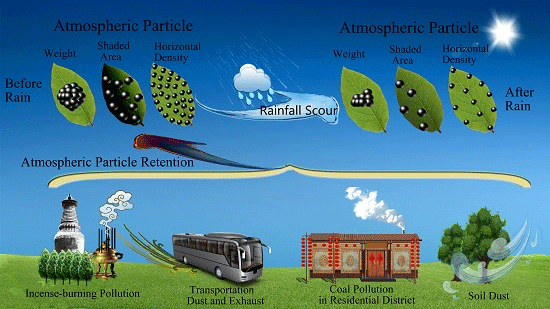Retention of Atmospheric Particles by Local Plant Leaves in the Mount Wutai Scenic Area, China
Abstract
:1. Introduction
2. Experimental Methods
2.1. Sampling Method of Particles on Leaf Surfaces
2.2. Analysis of Particles on Leaves
2.3. Evaluation of Leaf Purification Capacity
3. Results and Discussion
3.1. Retention of Particle Weight on Leaves and Related Analysis
3.2. Shaded Area by Particles Retained on Leaf Surfaces and Related Analysis
3.3. Analysis of Horizontal Density of Particles Retained on Leaves and the Purification Effect
3.4. Evaluation and Analysis of Purification Capacity of Particulate Pollution Retained on Leaf Surfaces
4. Conclusions
Acknowledgments
Author Contributions
Conflicts of Interest
Abbreviations
| Po. Davidiana | Populus davidiana |
| R. Hugonis | Rosa hugonis Hemsl. |
| B. Platyphylla | Betula platyphylla Suk. |
| R. Xanthina | Rosa xanthina Lindl. |
| Pe. Sepium | Periploca sepium Bunge |
| S. Salicifolia | Spiraea salicifolia L. |
| V. negundo var. Heterophylla | Vitex negundo var. Heterophylla |
| Pi. Tabuliformis | Pinus tabuliformis Carrière |
References
- Nation Bureau of Statistics of the People’s Republic of China. Available online: http://data.stats.gov.cn/easyquery.htm?cn=C01 (accessed on 26 February 2015).
- China National Tourism Administration. Available online: http://www.cnta.gov.cn/xxfb/wxzl/201506/t20150625_430725.shtml (accessed on 24 November 2011).
- The Buddhist Association of China. China Buddhist Temple of 2010, Version 2; Chinese Buddhist Press: Hangzhou, China, 2010. (In Chinese) [Google Scholar]
- Wang, B.; Lee, S.C.; Ho, K.F.; Kang, Y.M. Characteristics of emissions of air pollutants from burning of incense in temples, Hong Kong. Sci. Total Environ. 2007, 377, 52–60. [Google Scholar] [CrossRef] [PubMed]
- Zhang, J.P.; Chen, W.J.; Li, J.N.; Yu, S.J.; Zhao, W.Z. VOCs and particulate pollution due to incense burning in temples, China. Procedia Eng. 2015, 121, 992–1000. [Google Scholar] [CrossRef]
- Navasumrit, P.; Arayasiri, M.; Hiang, O.M.T.; Leechawengwongs, M.; Promvijit, J.; Choonvisase, S.; Chantchaemsai, S.; Nakngam, N.; Mahidol, C.; Ruchirawat, M. Potential health effects of exposure to carcinogenic compounds in incense smoke in temple workers. Chem. Biol. Interact. 2008, 173, 19–31. [Google Scholar] [CrossRef] [PubMed]
- Nowak, D.J.; Crane, D.E.; Stevens, J.C. Air pollution removal by urban trees and shrubs in the United States. Urban For. Urban Green. 2006, 4, 115–123. [Google Scholar] [CrossRef]
- Schaubroeck, T.; Deckmyn, G.; Neirynck, J.; Staelens, J.; Adriaenssens, S.; Dewulf, J.; Muys, B.; Verheyrn, K. Multilayered modeling of particulate matter removal by a growing forest over time, from plant surface deposition to washoff via rainfall. Environ. Sci. Technol. 2014, 48, 10785–10794. [Google Scholar] [CrossRef] [PubMed]
- Terzaghi, E.; Wild, E.; Zacchello, G.; Cerabolini, B.E.L.; Jones, K.C.; Guardo, A.D. Forest Filter Effect: Role of leaves in capturing/releasing air particulate matter and its associated PAHs. Atmos. Environ. 2013, 74, 378–384. [Google Scholar] [CrossRef]
- Nguyen, T.; Yu, X.X.; Zhang, Z.M.; Liu, M.M.; Liu, X.H. Relationship between types of urban forest and PM2.5 capture at three growth stages of leaves. J. Environ. Sci.-China 2015, 27, 33–41. [Google Scholar] [CrossRef] [PubMed]
- Wang, L.; Gong, H.L.; Liao, W.B.; Wang, Z. Accumulation of particles on the surface of leaves during leaf expansion. Sci. Total Environ. 2015, 532, 420–434. [Google Scholar] [CrossRef] [PubMed]
- Liu, X.H.; Yu, X.X.; Zhang, Z.M. PM2.5 concentration differences between various forest types and its correlation with forest structure. Atmosphere 2015, 6, 1801–1815. [Google Scholar] [CrossRef]
- Rai, R.K. Impacts of particulate matter pollution on plants: Implications for environmental biomonitoring. Ecotoxicol. Environ. Saf. 2016, 129, 120–136. [Google Scholar] [CrossRef] [PubMed]
- Prajapati, S.K.; Tripathi, B.D. Seasonal variation of leaf dust accumulation and pigment content in plant species exposed to urban particulates pollution. J. Environ. Qual. 2008, 37, 865–870. [Google Scholar] [CrossRef] [PubMed]
- Corrêa, A.X.R.; Cotelle, S.; Millet, M.; Somensi, C.A.; Wagner, T.M.; Radetski, C.M. Genotoxicity assessment of particulate matter emitted from heavy-duty diesel-powered vehicles using the in vivo Vicia faba L. micronucleus test. Ecotoxicol. Environ. Saf. 2016, 127, 199–204. [Google Scholar] [CrossRef] [PubMed]
- Arrivabene, H.P.; Souza, I.C.; Có, W.L.O.; Conti, M.M.; Wunderlin, D.A.; Milanez, C.R.D. Effect of pollution by particulate iron on the morphoanatomy, histochemistry, and bioaccumulation of three mangrove plant species in Brazil. Chemosphere 2015, 127, 27–34. [Google Scholar] [CrossRef] [PubMed]
- Wu, Z.H.; Liu, F.W.; Fan, W.H. Characteristics of PM10 and PM2.5 at Mount Wutai Buddhism scenic spot, Shanxi, China. Atmosphere 2015, 6, 1195–1210. [Google Scholar] [CrossRef]
- Wu, Z.H.; Fan, W.H.; Liu, F.W.; Duan, Q.Q.; Wang, K.; Liu, X.X. Air quality and its temporal and spatial characteristic analysis in Mount Wutai scenic area. Environ. Pollut. Control 2015, 06, 63–68. [Google Scholar]
- Plant Photo Bank of China, PPBC. Available online: http://www.plantphoto.cn/ (accessed on 23 July 2016).
- Janhäll, S. Review on urban vegetation and particle air pollution-deposition and dispersion. Atmos. Environ. 2015, 105, 130–137. [Google Scholar] [CrossRef]
- Tiwary, A.; Sinnett, D.; Peachey, C.; Chalabi, Z.; Vardoulakis, S.; Fletcher, T.; Leonardi, G.; Grundy, C.; Azapagic, A.; Hutchings, T.R. An integrated tool to assess the role of new planting in PM10 capture and human health benefits: A case study in London. Environ. Pollut. 2009, 157, 2645–2653. [Google Scholar] [CrossRef] [PubMed]
- Tallis, M.; Taylor, G.; Sinnett, D.; Freer-Smith, P. Estimating the removal of atmospheric particulate pollution by the urban tree canopy of London, under current and future environments. Landscape Urban Plan. 2011, 103, 129–138. [Google Scholar] [CrossRef]
- Prusty, B.A.K.; Mishra, P.C.; Azeez, P.A. Dust accumulation and leaf pigment content in vegetation near the national highway at Sambalpur, Orissa, India. Ecotoxicol. Environ. Saf. 2005, 60, 228–235. [Google Scholar] [CrossRef] [PubMed]
- Pankow, J.F.; Marks, M.C.; Barsanti, K.C.; Mahmud, A.; Asher, W.E.; Li, J.Y.; Ying, Q.; Jathar, S.H.; Kleeman, M.J. Molecular view modeling of atmospheric organic particulate matter: Incorporating molecular structure and co-condensation of water. Atmos. Environ. 2015, 122, 400–408. [Google Scholar] [CrossRef]
- Ouyang, W.; Guo, B.B.; Cai, G.Q.; Li, Q.; Han, S.; Liu, B.; Liu, X.G. The washing effect of precipitation on particulate matter and the pollution dynamics of rainwater in downtown Beijing. Sci. Total Environ. 2015, 505, 306–314. [Google Scholar] [CrossRef] [PubMed]
- Beckett, K.P.; Freer-Smith, P.H.; Taylor, G. Particulate pollution capture by urban trees: Effect of species and wind speed. Glob. Chang. Biol. 2000, 6, 995–1103. [Google Scholar] [CrossRef]
- Sæbø, A.; Popek, R.; Nawrot, B.; Hanslin, H.M.; Gawronska, H.; Gawronski, S.W. Plant species differences in particulate matter accumulation on leaf surfaces. Sci. Total Environ. 2012, 427, 347–354. [Google Scholar] [CrossRef] [PubMed]
- Dzierzanowski, K.; Popek, R.; Gawrońska, H.; Saebø, A.; Gawroński, S.W. Deposition of particulate matter of different size fractions on leaf surfaces and in waxes of urban forest species. Int. J. Phytoremediat. 2011, 13, 1037–1046. [Google Scholar] [CrossRef] [PubMed]
- Wang, W.X.; Fan, C.Q. Gas/solid particulate phthalic esters (PAEs) in Masson pine (Pinus massoniana L.) needles and rhizosphere surface soils. J. Hazard Mater. 2014, 276, 149–156. [Google Scholar] [CrossRef] [PubMed]
- Net, S.; Delmont, A.; Sempéré, R.; Paluselli, A.; Ouddane, B. Reliable quantification of phthalates in environmental matrices (air, water, sludge, sediment and soil): A review. Sci. Total Environ. 2015, 515–516, 162–180. [Google Scholar] [CrossRef] [PubMed]
- Popek, R.; Gawrońska, H.; Wrochna, M.; Gawroński, S.W. Particulate matter on foliage of 13 woody species: Deposition on surfaces and phytostabilisation in waxes a 3-year study. Int. J. Phytoremediat. 2013, 15, 245–256. [Google Scholar] [CrossRef] [PubMed]
- Dolinová, J.; Klánová, J.; Klán, P.; Holoubek, I. Photodegradation of organic pollutants on the spruce needle wax surface under laboratory conditions. Chemosphere 2004, 57, 1399–1407. [Google Scholar] [CrossRef] [PubMed]
- Klánová, J.; Čupr, P.; Baráková, D.; Šeda, Z.; Anděl, P.; Holoubek, I. Can pine needles indicate trends in the air pollution levels at remote sites? Environ. Pollut. 2009, 157, 3248–3254. [Google Scholar] [CrossRef] [PubMed]
- Iozza, S.; Schmid, P.; Oehme, M. Development of a comprehensive analytical method for the determination of chlorinated paraffins in spruce needles applied in passive air sampling. Environ. Pollut. 2009, 157, 3218–3224. [Google Scholar] [CrossRef] [PubMed]
- Li, Y.G.; Chen, B.L.; Zhu, L.Z. Single-solute and bi-solute sorption of phenanthrene and pyrene onto pine needle cuticular fractions. Environ. Pollut. 2010, 158, 2478–2484. [Google Scholar] [CrossRef] [PubMed]
- Ould-Dada, Z.; Baghini, N.M. Resuspension of small particles from tree surfaces. Atmos. Environ. 2001, 35, 3799–3809. [Google Scholar] [CrossRef]
- Freer-Smith, P.H.; Beckett, K.P.; Taylor, G. Deposition velocities to sorbus aria, Acer campestre, populus deltoides × trichocarpa “beaupré”, pinus nigra and × Cupressocyparis leylandii for coarse, fine and ultra-fine particles in the urban environment. Environ. Pollut. 2005, 133, 157–167. [Google Scholar] [CrossRef] [PubMed]
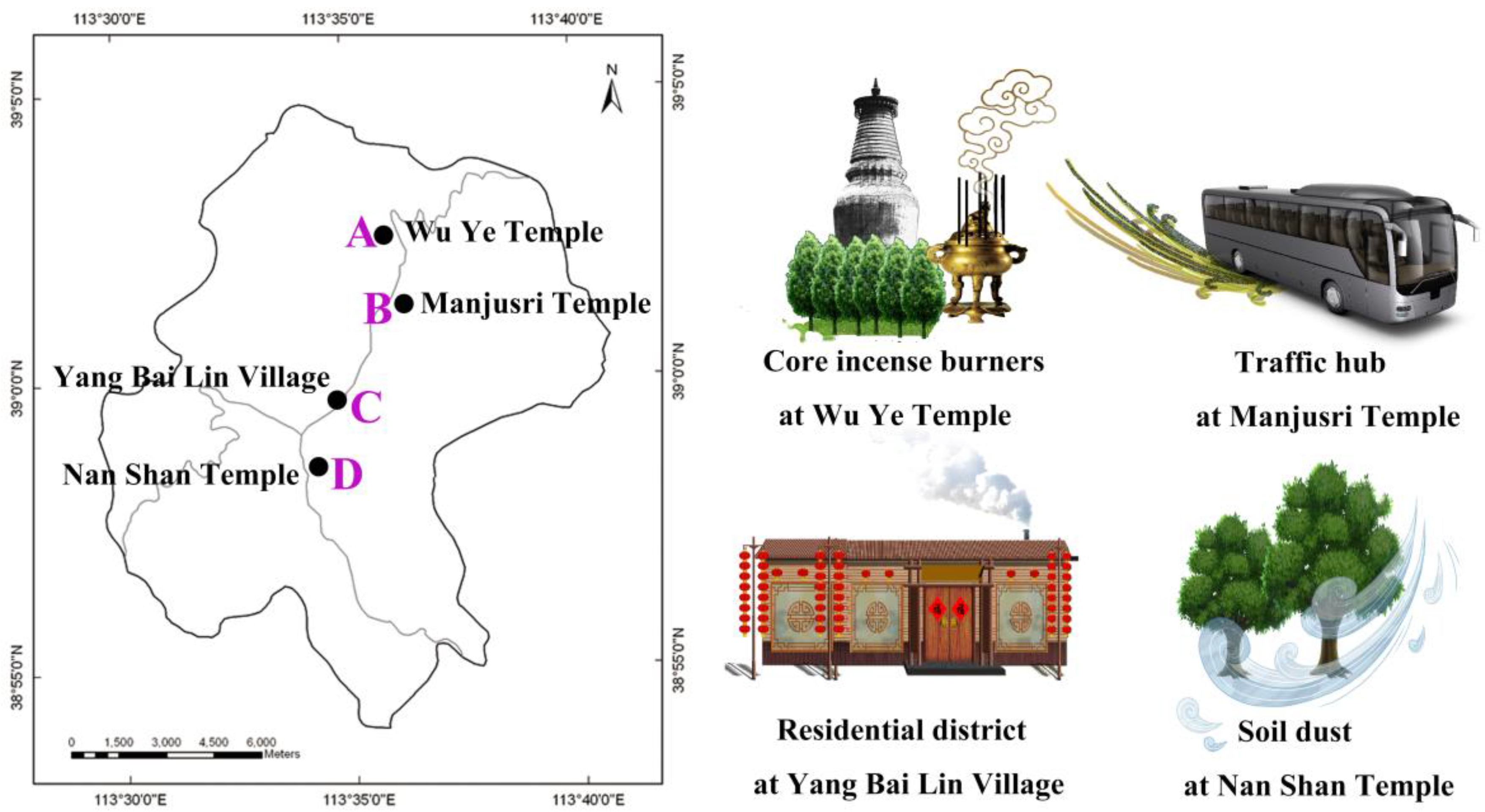
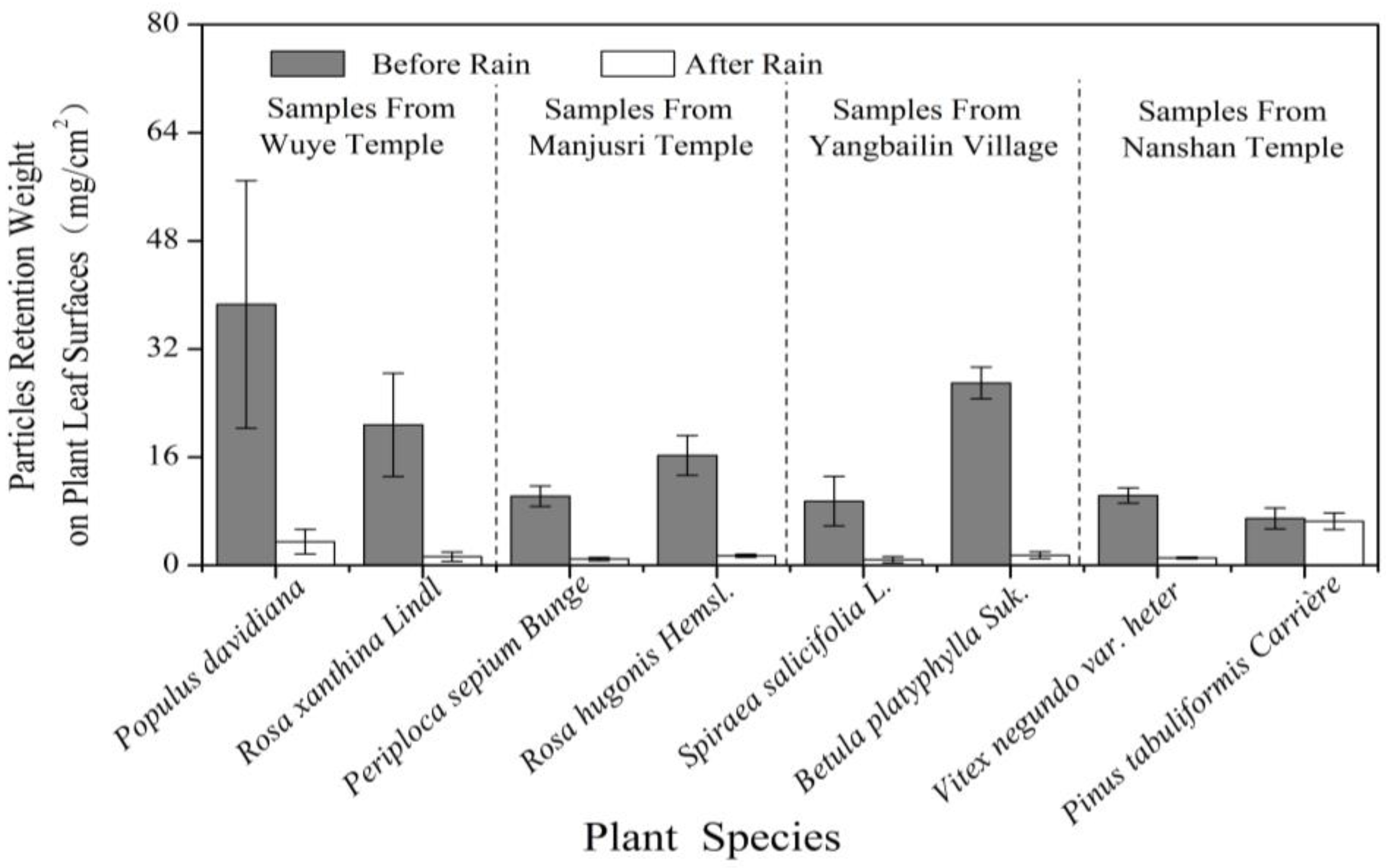
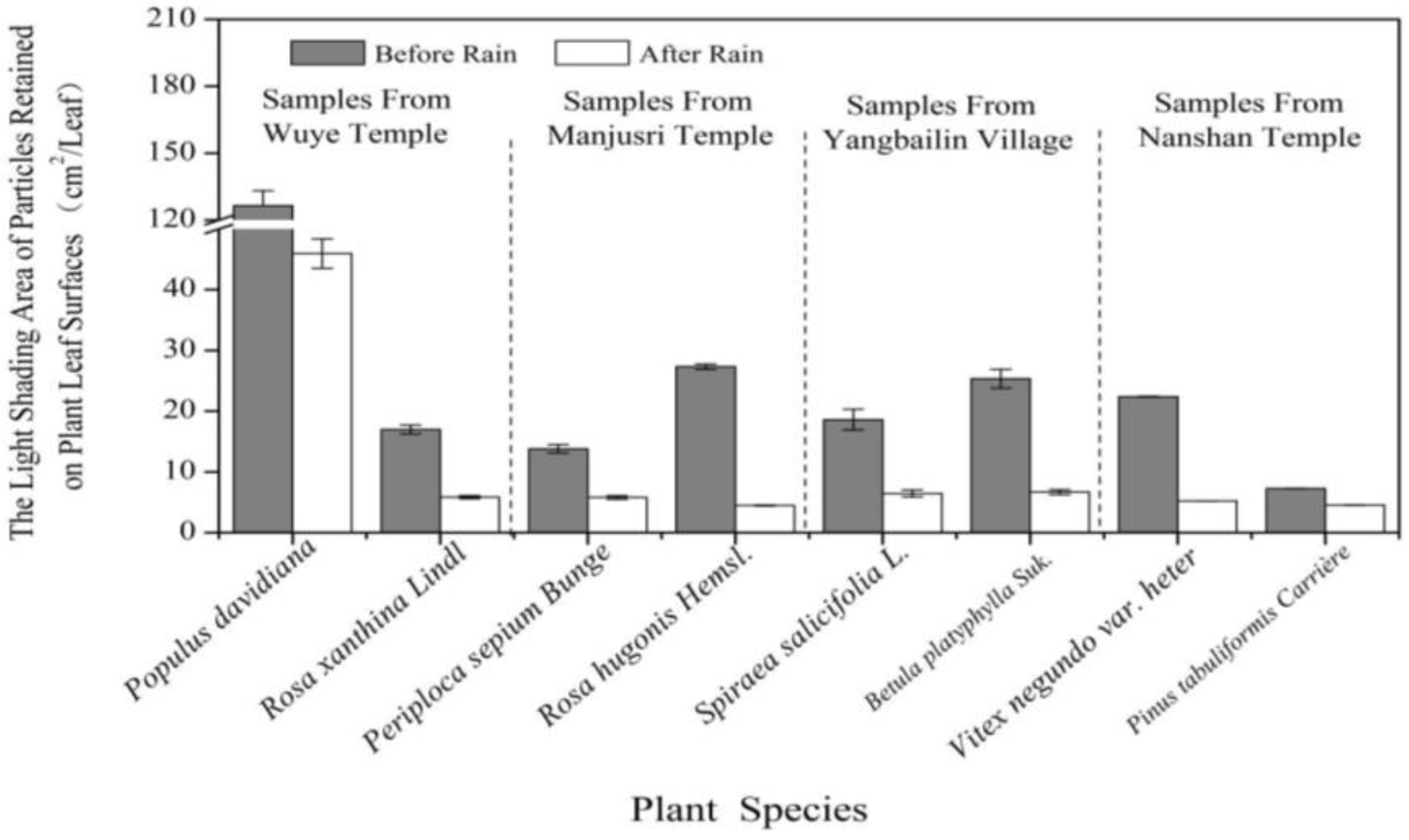
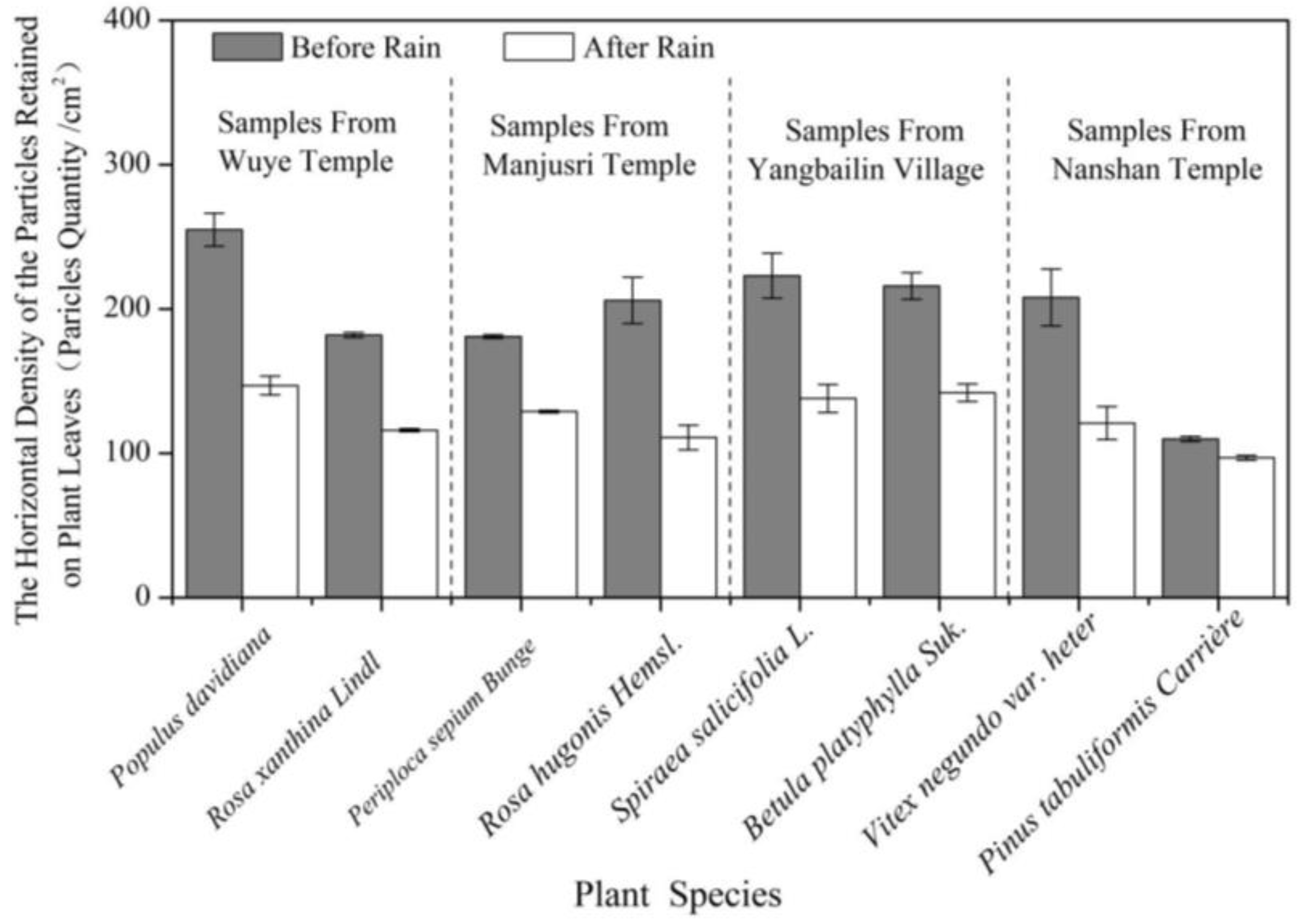
| Evaluation Item/Plant | Po. davidiana | R. xanthina | Pe. sepium | R. hugonis | S. salicifolia | B. platyphylla | V. negundo var. heterophylla | Pi. tabuliformis | |
|---|---|---|---|---|---|---|---|---|---|
| Sub-coefficient of particle retention quality | Before rain | 1 | 3 | 6 | 4 | 7 | 2 | 5 | 8 |
| Removal percentage after rain | 6 | 2 | 5 | 3 | 4 | 1 | 7 | 8 | |
| Sub-coefficient of particle shaded area | Before rain | 1 | 6 | 7 | 2 | 5 | 3 | 4 | 8 |
| Removal percentage after rain | 6 | 4 | 7 | 1 | 5 | 3 | 2 | 8 | |
| Sub-coefficient of particle horizontal density | Before rain | 1 | 6 | 7 | 5 | 2 | 3 | 4 | 8 |
| Removal percentage after rain | 2 | 5 | 7 | 1 | 4 | 6 | 3 | 8 | |
| Total evaluation coefficient | 17 | 26 | 39 | 16 | 27 | 18 | 25 | 48 | |
© 2016 by the authors; licensee MDPI, Basel, Switzerland. This article is an open access article distributed under the terms and conditions of the Creative Commons Attribution (CC-BY) license (http://creativecommons.org/licenses/by/4.0/).
Share and Cite
Shi, S.; Wu, Z.; Liu, F.; Fan, W. Retention of Atmospheric Particles by Local Plant Leaves in the Mount Wutai Scenic Area, China. Atmosphere 2016, 7, 104. https://doi.org/10.3390/atmos7080104
Shi S, Wu Z, Liu F, Fan W. Retention of Atmospheric Particles by Local Plant Leaves in the Mount Wutai Scenic Area, China. Atmosphere. 2016; 7(8):104. https://doi.org/10.3390/atmos7080104
Chicago/Turabian StyleShi, Shuai, Zhihui Wu, Fenwu Liu, and Wenhua Fan. 2016. "Retention of Atmospheric Particles by Local Plant Leaves in the Mount Wutai Scenic Area, China" Atmosphere 7, no. 8: 104. https://doi.org/10.3390/atmos7080104




